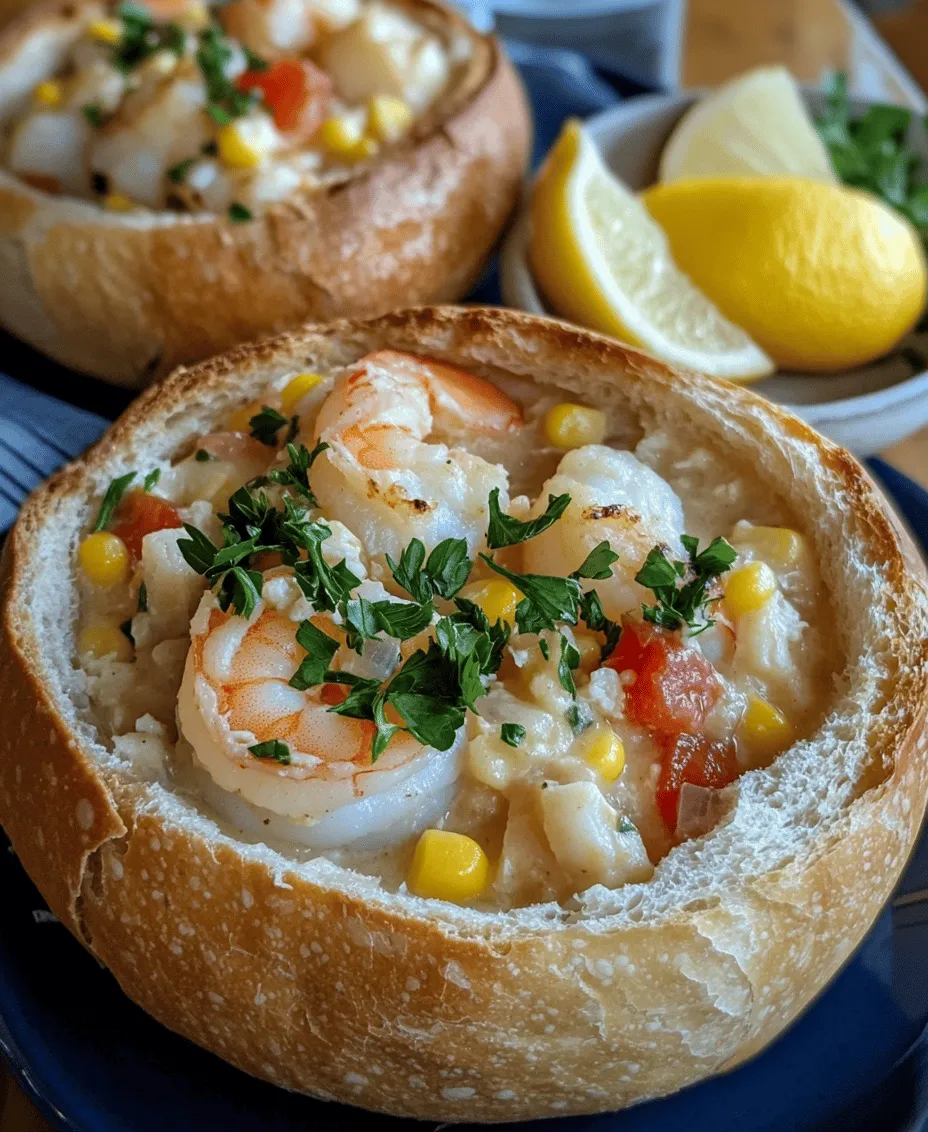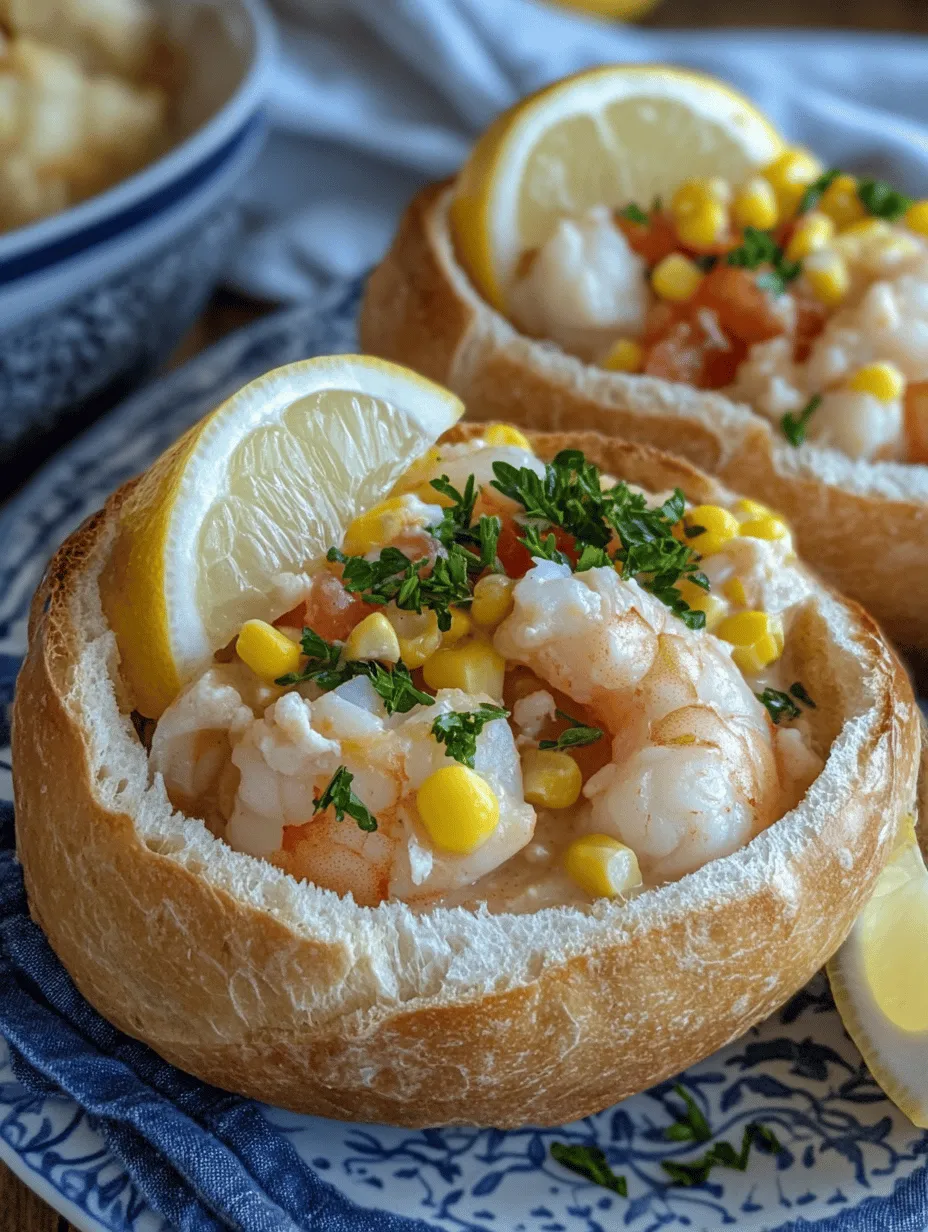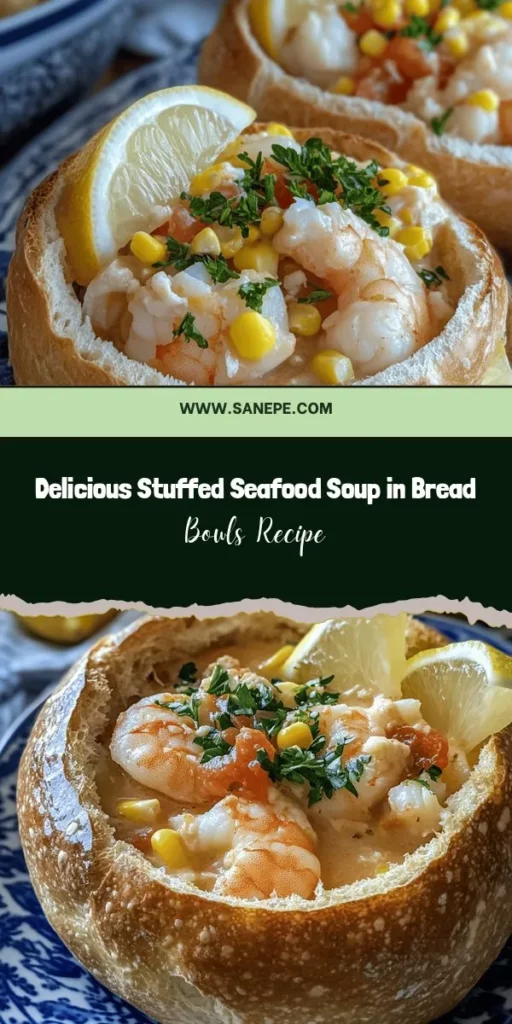Introduction
If you’re seeking a comforting and unique dining experience, the Stuffed Seafood Soup Bread Bowl is the perfect dish to tantalize your taste buds. This delightful recipe combines the rich flavors of fresh seafood with the comforting warmth of a creamy soup, all elegantly served within a freshly baked bread bowl. The appeal of this dish lies not only in its taste but also in its presentation and the experience it offers. Imagine digging into a bowl of luscious seafood soup, the aroma of herbs and spices wafting through the air, and savoring every bite as you enjoy the accompanying bread, which has absorbed the savory broth.
Combining various flavors and textures is essential in creating a dish that is both satisfying and memorable. The crunchy exterior of the artisan bread contrasts beautifully with the creamy, rich soup inside, while the medley of seafood provides a delightful chewiness that elevates the entire experience. Each component plays a vital role, harmonizing to create a meal that warms the soul and excites the palate. Whether you are hosting a dinner party, looking for a family-friendly meal, or simply craving something different, this stuffed seafood soup bread bowl is sure to impress.
Understanding the Ingredients
To fully appreciate the Stuffed Seafood Soup Bread Bowl, it’s important to understand the role of each ingredient in this recipe. The careful selection of components not only enhances the dish’s flavor but also contributes to its nutritional value.
Artisan Bread Bowls
At the heart of this dish are the artisan bread bowls. The choice of bread is crucial; it should be fresh, crusty on the outside, and soft on the inside to create the perfect vessel for the seafood soup. A well-made bread bowl provides a satisfying crunch while also allowing the soup to seep in, creating a wonderful texture. When selecting bread, look for options like sourdough or crusty baguettes that have a sturdy structure to hold the soup without falling apart.
Mixed Seafood
The seafood mix is the star of the show, and using a combination of shrimp, scallops, and crab adds depth and variety to the dish. Shrimp brings a sweet and slightly briny flavor, while scallops offer a delicate, buttery taste. Crab, with its tender, flaky meat, adds a luxurious touch. Not only do these seafood varieties provide a complex flavor profile, but they are also packed with nutrients. Rich in protein, omega-3 fatty acids, and essential vitamins, seafood is a healthy choice that makes this dish not only delicious but nourishing as well.
Heavy Cream and Seafood Stock
The base of the soup is made rich and creamy with the addition of heavy cream, which gives it a velvety texture that envelops the seafood beautifully. Seafood stock, ideally homemade, provides an additional layer of flavor that enhances the overall richness of the soup. This combination creates a decadent broth that complements the seafood perfectly, ensuring every spoonful is a delight.
Aromatics: Onion and Garlic
No great soup is complete without the foundational flavors brought by aromatics. Onion and garlic are essential for building the depth of flavor in your seafood soup. When sautéed, they release their natural sweetness, which balances the brininess of the seafood. The aromatic blend creates a fragrant base that will permeate the entire dish, inviting everyone to the table.
Diced Tomatoes and Corn
To add freshness and sweetness, diced tomatoes and corn are included in the recipe. The tomatoes provide acidity, which brightens the dish, while corn adds a touch of sweetness and a pleasant crunch. This combination not only enhances the flavor but also adds visual appeal with vibrant colors.
Olive Oil, White Wine, Old Bay Seasoning, and Paprika
To elevate the flavors further, olive oil is used for sautéing, imparting a fruity richness. White wine adds acidity and depth, making the dish more complex. Old Bay seasoning, a classic in seafood dishes, introduces a blend of spices that perfectly complements the seafood. Paprika, with its smoky undertones, rounds out the flavor profile and adds a beautiful color to the soup.
Seasoning: Salt, Pepper, and Garnishes
The final touch comes from seasoning the soup with salt and pepper. These basic seasonings are essential for bringing out the natural flavors of the ingredients. Additionally, garnishing with fresh herbs, such as parsley or chives, not only adds brightness but also enhances the presentation of the dish.
Nutritional Benefits of the Main Ingredients
The Stuffed Seafood Soup Bread Bowl is not only a feast for the senses but also a nutritious meal option. The seafood provides high-quality protein and essential fatty acids, supporting heart health and overall well-being. The vegetables, like onions, tomatoes, and corn, contribute vitamins, minerals, and fiber, making this dish balanced and wholesome. The use of artisan bread adds carbohydrates to fuel your energy needs, making it a satisfying meal.
Preparation Steps Explained
Now that we’ve explored the ingredients and their significance, let’s delve into the preparation steps that will guide you in creating this scrumptious Stuffed Seafood Soup Bread Bowl.
Preparing the Bread Bowls
The first step in this delightful recipe is preparing the bread bowls. Start by selecting your artisan bread. Aim for a round loaf that is sturdy enough to hold the soup. A sourdough or crusty boule works beautifully.
1. Cut the Top Off: Using a serrated knife, carefully slice the top off the bread loaf. Set this piece aside; it will serve as a lid for your bread bowl.
2. Hollow It Out: With a smaller knife or a spoon, gently hollow out the inside of the bread, leaving enough of the crust intact to hold the soup. Be careful not to puncture the bottom or sides, as you want to maintain the integrity of the bowl.
3. Toast the Bread: For added texture and flavor, you can brush the inside of the hollowed bread with olive oil and place it in the oven for about 5-10 minutes at 350°F (175°C). This will create a crisp interior that can withstand the soup without getting soggy too quickly.
Importance of Hollowing Out the Bowls Correctly
Hollowing out the bread bowls is a crucial step. If you remove too much bread, the bowl may collapse under the weight of the soup. Conversely, leaving too much bread can lead to a dry and overly doughy experience. Aim for a hollow that has about a half-inch thick wall, which allows for a good balance of bread and soup.
Tips for Maximizing Texture and Flavor in the Bread
– Use Fresh Bread: Always opt for fresh artisan bread for the best flavor and texture. Stale bread will not hold up well and can lead to a disappointing dish.
– Season the Bread: Consider adding a sprinkle of garlic powder or Italian herbs to the inside of the bread before baking for an extra layer of flavor.
– Serve Warm: Ensure the bread bowls are served warm to enhance the overall experience. Warm bread paired with hot soup creates a cozy, comforting meal.
Sautéing Aromatics
The next step involves sautéing the aromatics, which is a fundamental technique in creating depth of flavor for your soup.
1. Heat the Olive Oil: In a large pot, heat a tablespoon of olive oil over medium heat. You want just enough oil to coat the bottom of the pot, which will help prevent sticking and promote even cooking.
2. Add the Onions: Once the oil is hot, add the diced onions. Sauté them for about 3-4 minutes, or until they become translucent and fragrant. Stir frequently to ensure even cooking and prevent burning.
3. Incorporate the Garlic: After the onions have softened, add minced garlic to the pot. Sauté for an additional minute, just until the garlic is fragrant. Be cautious not to let it brown too much, as burnt garlic can impart a bitter taste to your soup.
The Significance of Sautéing and How It Enhances the Dish’s Overall Flavor
Sautéing the aromatics serves several important purposes. First, it draws out the natural sugars in the onions, creating a sweet base that balances the savory elements of the dish. Second, the heat helps to release the essential oils in the garlic, contributing to the overall aroma and flavor profile of the soup. This initial step sets the stage for a rich, flavorful broth, making it essential for the success of your stuffed seafood soup.
As you embark on creating your own Stuffed Seafood Soup Bread Bowl, remember that each step builds upon the last, contributing to an exquisite final product that is as enjoyable to prepare as it is to eat. With the right ingredients and techniques, you’ll soon be savoring a dish that brings warmth and comfort to your table.

Cooking the Seafood
Cooking seafood requires precision and attention to detail to ensure it retains its delicate texture and flavor. Begin by selecting fresh seafood, such as shrimp, scallops, and crab meat. These ingredients will form the star of your stuffed seafood soup.
To cook the seafood perfectly, heat a tablespoon of olive oil in a large pot over medium heat. Once the oil is shimmering, add the seafood in batches to avoid overcrowding, which can lead to steaming rather than sautéing. Cook for about 2-3 minutes until the seafood is just opaque. Shrimp should turn pink, while scallops should develop a golden crust on the outside. Take care not to overcook, as seafood can become rubbery if left on the heat too long.
Techniques for Ensuring Seafood is Perfectly Cooked
1. Temperature Control: Keep the heat at medium to allow for even cooking. Too high a temperature can lead to burnt exteriors and raw interiors.
2. Timing: Each type of seafood has a different cooking time. Shrimp cooks quickly, while larger pieces like scallops may need a minute or two longer.
3. Residual Heat: Remember that seafood will continue to cook even after it’s taken off the heat due to residual heat. Remove it from the pot just before it’s finished cooking to avoid overcooking.
How White Wine Contributes to the Dish’s Depth of Flavor
Once your seafood is perfectly cooked, it’s time to add white wine to the pot. A dry white wine, like Sauvignon Blanc or Pinot Grigio, enhances the overall flavor profile of the soup. The acidity in wine brightens the dish, cutting through the richness of the seafood and stock. Pour in about half a cup of white wine, scraping any brown bits from the bottom of the pot to incorporate those flavors. Allow the wine to reduce for a couple of minutes, which will deepen the flavors and add a lovely complexity to your soup.
Adding Vegetables and Stock
Incorporating vegetables into your soup not only adds texture and flavor but also contributes to the nutritional value of the dish. Common choices include diced onions, carrots, celery, and bell peppers. Sauté these vegetables alongside the seafood until they’re tender and fragrant, about 5-7 minutes.
The Role of Each Ingredient in Achieving Balance and Body
– Onions: Provide a sweet base flavor that complements the seafood.
– Carrots: Add natural sweetness and color.
– Celery: Contributes crunch and a slightly peppery flavor.
– Bell Peppers: Offer a burst of freshness and color.
Once your vegetables are tender, it’s time to add the stock. Use either a seafood stock for a bolder flavor or a vegetable stock for a lighter touch. The liquid will form the base of your soup, infusing the dish with additional depth. Bring the mixture to a gentle boil, then reduce to a simmer.
Discussion on Simmering: How It Affects Flavor Development
Simmering is a crucial step in developing the flavors of your soup. By allowing the soup to simmer, the ingredients have time to meld, and the flavors intensify. This process typically takes about 20-30 minutes. During this time, you can add herbs like thyme, bay leaves, or parsley to further enhance the flavor profile. Remember to taste and adjust the seasoning with salt and pepper throughout the simmering process for optimal flavor balance.
Serving Preparation
When it comes to serving your stuffed seafood soup, presentation is key. Ladling the soup into bread bowls without spilling can be a challenge. Here are some tips to ensure a seamless serving experience:
1. Use a Ladle: A ladle with a spout can help control the flow of the soup.
2. Tilt the Bowl: Slightly tilt the bread bowl as you pour to make it easier to fill without overflowing.
3. Fill Gradually: Pour slowly and steadily, allowing the soup to settle before adding more.
Importance of Presentation and Garnishing
A well-presented dish elevates the dining experience. Consider garnishing your soup with fresh herbs, a dollop of cream, or a sprinkle of paprika for added color and flavor. Placing a sprig of parsley or a slice of lemon on the side of the bread bowl not only looks appealing but also adds a fresh zest that complements the seafood flavors.
Baking the Bread Bowls
Baking the bread bowls is a crucial step that adds an enjoyable texture to your dish. You’ll want to use a sturdy bread like sourdough or a round artisan loaf that can hold the soup without becoming soggy.
Explanation of the Baking Step
To prepare the bread bowls, preheat your oven to 375°F (190°C). Slice the tops off the loaves and hollow out the insides, leaving enough bread on the sides to hold the soup. Brush the insides lightly with olive oil and season with salt and pepper. Place them on a baking sheet and bake for 10-15 minutes until they are lightly toasted and golden brown.
Importance of Achieving the Right Texture in the Bread
The texture of the bread bowl is paramount. A perfectly baked bread bowl should be crusty on the outside while remaining soft on the inside. This contrast provides a delightful eating experience as you scoop the soup with each bite.
How the Oven Time Affects the Overall Dining Experience
The baking time not only helps the bread maintain its structure but also enhances its flavor. The Maillard reaction during baking creates a rich, toasted flavor that complements the savory seafood soup. Serve the bread bowls warm to ensure the best experience.
Flavor Pairings
Pairing flavors is essential to creating a harmonious meal. For your stuffed seafood soup bread bowl, consider these complementary sides and beverages:
– Suggested Pairings for the Seafood Soup Bread Bowl:
– A light, refreshing salad with mixed greens, cherry tomatoes, and a lemon vinaigrette balances the richness of the soup.
– Crusty garlic bread is always a delightful companion, perfect for dipping.
– Complementary Beverages:
– A crisp white wine, such as a Sauvignon Blanc or a Pinot Grigio, pairs beautifully with the seafood, enhancing the dish’s overall flavor.
– For a non-alcoholic option, a sparkling water with a slice of citrus can provide a refreshing contrast.
– How to Balance Flavors with a Light Salad or a Crisp White Wine:
– The acidity in a light salad or crisp wine helps cut through the creaminess of the soup, providing a balanced palate experience.
Conclusion
The stuffed seafood soup bread bowl is more than just a meal; it’s a comforting and delicious dining experience that brings warmth and joy to any gathering. The combination of perfectly cooked seafood, rich stock, and hearty vegetables served in a freshly baked bread bowl creates a symphony of flavors that is both satisfying and memorable.
By following this recipe, you not only create a dish that is visually stunning but also one that will impress your family and friends. The unique blend of flavors and textures makes this recipe a must-try for seafood lovers and culinary enthusiasts alike.
So, roll up your sleeves and dive into the world of stuffed seafood soup bread bowls. This dish is sure to become a favorite in your home, reminding you of cozy nights spent around the table, enjoying good food and great company. Enjoy the comforting nature of this recipe and the smiles it brings to those you share it with.


